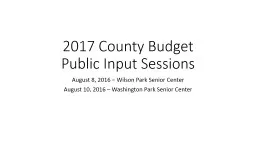

August 8 2016 Wilson Park Senior Center August 10 2016 Washington Park Senior Center County Executive Abeles Opening Remarks Importance of Public Input New format for discussion Final report ID: 701993
Download Presentation The PPT/PDF document "2017 County Budget Public Input Sessions" is the property of its rightful owner. Permission is granted to download and print the materials on this web site for personal, non-commercial use only, and to display it on your personal computer provided you do not modify the materials and that you retain all copyright notices contained in the materials. By downloading content from our website, you accept the terms of this agreement.
Slide1
2017 County BudgetPublic Input Sessions
August 8, 2016 – Wilson Park Senior Center
August 10, 2016 – Washington Park Senior CenterSlide2
County Executive Abele’s Opening Remarks
Importance of Public Input
New format for discussion
Final reportSlide3
Where does the money the County spends come from?
2016 County RevenuesSlide4
Where do my property tax dollars go?Slide5
How does the budget look for 2017?Slide6
What is causing the County’s budget gap?
Pension Contributions
Retiree Health Care Expenses
Transportation and other InfrastructureSlide7
County Fiscal Challenges:Retiree Health Care CostsSlide8
Retiree Pension CostsSlide9
Transportation InfrastructureSlide10
Reductions in Bus Fare RevenueSlide11
How could the County cut spending?
Reduce Staffing
Eliminate bus replacements and reduce routes - $13 millionSlide12
Reductions to County StaffSlide13
How could the County cut spending?
Eliminate Bus Replacements and Reduce Routes - $13 millionSlide14
How could the County increase revenues?
Property taxes - $4 million to $6 million per year
Charges for services - $75,000 to $1.5 million per year
Vehicle registration fee - $10 million to $25 million per year
Bus Fare Increases - $1 million to $4 million per yearSlide15
Property Tax Increase
Raising property taxes to account for new construction would increase revenue by $4 million. The tax bill for the average home would stay about the same.
Raising property taxes to account for all growth in property values would increase revenue by $6 million. The tax bill for the average home would go up $5 to $10.
State property tax caps limit the County’s ability to increase property taxes.Slide16
Charges for Services
Milwaukee County charges fees for hundreds of optional services provided to residents and visitors to Milwaukee County. Here are few that could be increased:
Parking fees on the lakeshore - $1.5 million per year
Parks concessions (beer gardens, restaurants, etc.) - $75,000 per year
Miscellaneous park fees (golf courses, marina rentals, etc.) - $85,000 per yearSlide17
Vehicle Registration Fee
Adding a County charge to State vehicle registration fees would increase revenues that could be used for the transportation system.
Annual Fee
2017
Revenue
$20
$7.8
million
$30
$11.8
million
$40
$15.7
million
$50
$19.6 millionSlide18
Comparison of Midwest Vehicle Registration FeesSlide19
Increase Bus Fares
Transit ridership and fare revenue vary based on factors like the amount of the fare and gas prices. Here are estimates of additional revenue from changes to fare bus fares:
Change in Fare
Estimated Annual Revenue
Increase general fare from $2.25
to $2.50
$1 million
Increase premium
fares including
freeway flyer fares from $3.25
to $3.50
$
1 million
Charge half fare
for elderly and disabled (currently free)
$4
millionSlide20Slide21
Instructions for Small Groups